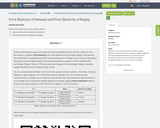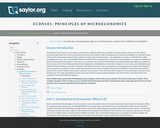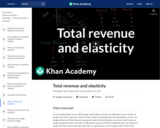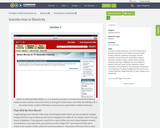50 Results

By the end of this section, you will be able to:
Calculate the price elasticity of demand
Calculate the price elasticity of supply
- Subject:
- Applied Science
- Material Type:
- Module
- Date Added:
- 09/20/2018

14.01 Principles of Microeconomics is an introductory undergraduate course that teaches the fundamentals of microeconomics. This course introduces microeconomic concepts and analysis, supply and demand analysis, theories of the firm and individual behavior, competition and monopoly, and welfare economics. Students will also be introduced to the use of microeconomic applications to address problems in current economic policy throughout the semester.
This course is a core subject in MIT's undergraduate Energy Studies Minor. This Institute-wide program complements the deep expertise obtained in any major with a broad understanding of the interlinked realms of science, technology, and social sciences as they relate to energy and associated environmental challenges.
Course Format
This course has been designed for independent study. It includes all of the materials you will need to understand the concepts covered in this subject. The materials in this course include:
A complete set of Lecture Videos by Prof. Jon Gruber.
Reading Assignments in your choice of two textbooks – one of which is a free online edition - as preparation for the lectures.
Multiple-choice Quizzes to assess your understanding of the key concepts in each session.
Problem Sets with solution keys to test your ability to apply to concepts covered in lecture, and Problem Solving Videos to provide step-by-step instruction through several problem set solutions.
A collection of links For Further Study to provide supplemental online content.
A full set of Exams, including review material and practice exams to help you prepare.
- Subject:
- Economics
- Social Science
- Material Type:
- Full Course
- Provider:
- MIT
- Provider Set:
- MIT OpenCourseWare
- Author:
- Gruber, Jonathan
- Date Added:
- 09/01/2011

The purpose of this course is to provide the student with a basic understanding of the principles of microeconomics. At its core, the study of economics deals with the choices and decisions that have to be made in order to manage scarce resources available to us. Microeconomics is the branch of economics that pertains to decisions made at the individual level, i.e. by individual consumers or individual firms, after evaluating resources, costs, and tradeoffs. "The economy" refers to the marketplace or system in which these choices interact with one another. In this course, the student will learn how and why these decisions are made and how they affect one another in the economy. Upon successful completion of this course, students will be able to: Think intuitively about economic problems; Identify how individual economic agents make rational choices given scarce resources and will know how to optimize the use of resources at hand; Understand some simplistic economic models related to Production, Trade, and the Circular Flow of Resources; Analyze and apply the mechanics of Demand and Supply for Individuals, Firms, and the Market; Apply the concept of Marginal Analysis in order to make optimal choices and identify whether the choices are 'efficient' or 'equitable'; Apply the concept of Elasticity as a measure of responsiveness to various variables; Identify the characteristic differences amongst various market structures, namely, Perfectly Competitive Markets, Non-Competitive Markets, and Imperfectly Competitive Markets and understand the differences in their operation; Analyze how the Demand and Supply technique works for the Resource Markets. (Economics 101; See also: Business Administration 200)
- Subject:
- Business and Communication
- Economics
- Management
- Social Science
- Material Type:
- Assessment
- Full Course
- Lecture
- Lecture Notes
- Reading
- Syllabus
- Textbook
- Provider:
- The Saylor Foundation
- Date Added:
- 11/18/2011

Student teams make polymers using ordinary household supplies (glue, borax, water). They experiment with the semi-solid material when warm and cold to see and feel its elastic and viscous properties. Students will begin to understand how the electrical forces between particles change as temperature or the force applied to the substance changes. Is it a solid, a liquid, or something in between? How might it be used?
- Subject:
- Applied Science
- Engineering
- Physical Science
- Physics
- Material Type:
- Activity/Lab
- Provider:
- TeachEngineering
- Provider Set:
- TeachEngineering
- Author:
- Jacqueline Lanfranchi
- Mark Bronski
- Mike Galecki
- Date Added:
- 09/18/2014

PowerPoint's originally created to assist deaf students to interpret supply and demand graphs, as they relate to elasticity of demand and tax incidence.

One of the most practical applications of price elasticity of demand is its relationship to total revenue. A seller who knows the price elasticity of demand for their good can make better decisions about what happens if they raise or lower the price of their good. Explore the relationship between total revenue and elasticity in this video. Created by Sal Khan.
- Subject:
- Economics
- Social Science
- Material Type:
- Lesson
- Provider:
- Khan Academy
- Provider Set:
- Khan Academy
- Author:
- Sal Khan
- Date Added:
- 07/27/2021

What is economics and why should you spend your time learning it? After all, there are other disciplines you could be studying, and other ways you could be spending your time. As the Bring it Home feature just mentioned, making choices is at the heart of what economists study, and your decision to take this course is as much an economic decision as anything else.
Economics is probably not what you think it is. It is not primarily about money or finance. It is not primarily about business. It is not mathematics. What is it then? It is both a subject area and a way of viewing the world.
- Subject:
- Economics
- Social Science
- Material Type:
- Textbook
- Provider:
- University of Hawaii
- Provider Set:
- Pressbooks
- Author:
- Cynthia Foreman
- Thomas Scheiding
- Date Added:
- 09/10/2019

These lecture videos were made during the pandemic when most classes went online. They cover most of Physics-1, and a few chapters of physics-2. Subject: Physics Level: Community CollegeMaterial Type: LectureAuthor: Khalid BukhariDate Added: 2/19/2024

Students are introduced to the concept of viscoelasticity and some of the material behaviors of viscoelastic materials, including strain rate dependence, stress relaxation, creep, hysteresis and preconditioning. Viscoelastic material behavior is compared to elastic solids and viscous fluids. Students learn about materials that have viscoelastic behavior along with the importance of engineers understanding viscoelasticity. To best engage the students, conduct the first half of the associated Creepy Silly Putty activity before conducting this lesson.
- Subject:
- Applied Science
- Engineering
- Physical Science
- Physics
- Material Type:
- Lesson Plan
- Provider:
- TeachEngineering
- Provider Set:
- TeachEngineering
- Author:
- Brandi N. Briggs
- Marissa H. Forbes
- Date Added:
- 09/18/2014
